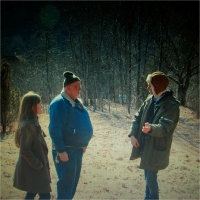 Dirty Projectors: Swing Lo Magellan (Domino, 7/10/12)
Dirty Projectors: Swing Lo Magellan (Domino, 7/10/12)
“Gun Has No Trigger”
Dirty Projectors: “Gun Has No Trigger”
Earlier this year, when Dirty Projectors offered a stream of the new song “Gun Has No Trigger,” it felt like the band was fending off fans, critics, and music blogs with a stick — keeping them at bay, buying more time to wrap up more songs. Ever since the release of its schizo-indie breakthrough, Bitte Orca, in 2009, the band has become a bearer of the “most anticipated album” tag, as the expectations for follow-up Swing Lo Magellan have swelled to ridiculous proportions.
Those expectations, however, aren’t unfounded. The New York-based band, helmed by front-man David Longstreth and a barrage of skilled singers/musicians, has always had a knack for thinking outside the box — creating skittish, unconventional pop frameworks and augmenting them with twists of cleverness and turns of impulse. And Swing Lo Magellan, the band’s sixth proper album, is no different, furthering Dirty Projectors’ gift for melding catchy constructions within progressive parameters.
But while Dirty Projectors’ work can sometimes be construed as experimentalism for the sake of experimentalism, much of Swing Lo Magellan is content to rely on the strength of the songs and not shtick. For instance, the title track is one of the most straightforward songs the band has ever crafted — featuring a lone vocal track, a breezy acoustic guitar, a subdued bass line, and a subtle drum rhythm. And songs like “Irresponsible Tune,” “Impregnable Question,” and “Unto Caesar” don’t stray too far from the downplayed instrumentation and no-nonsense approach too often (though each one has its share of eccentricities).
Nevertheless, even with those more conventional techniques in place, the band sticks to its guns and employs some off-the-cuff tactics. Whether it’s the swarming and sprawling voices in “Gun Has No Trigger,” the complex drum patterns in “About to Die,” the swooning strings toward the end of “Dance For You,” or the incessant percussion and space-cadet guitars on “See What She Seeing,” the album is content to tweak and twist conventional songwriting motifs, fashioning the songs into something both accessible yet arresting.
That approach is accomplished by the band’s ability to hone in on solid songwriting. With all of the hullabaloo surrounding the release, the band is happy to let the songs speak for themselves, relying on sound writing, attention to detail, and experiments in minimalism not seen on previous releases. With all this considered, it’s no surprise that Swing Lo Magellan was worth the wait.

